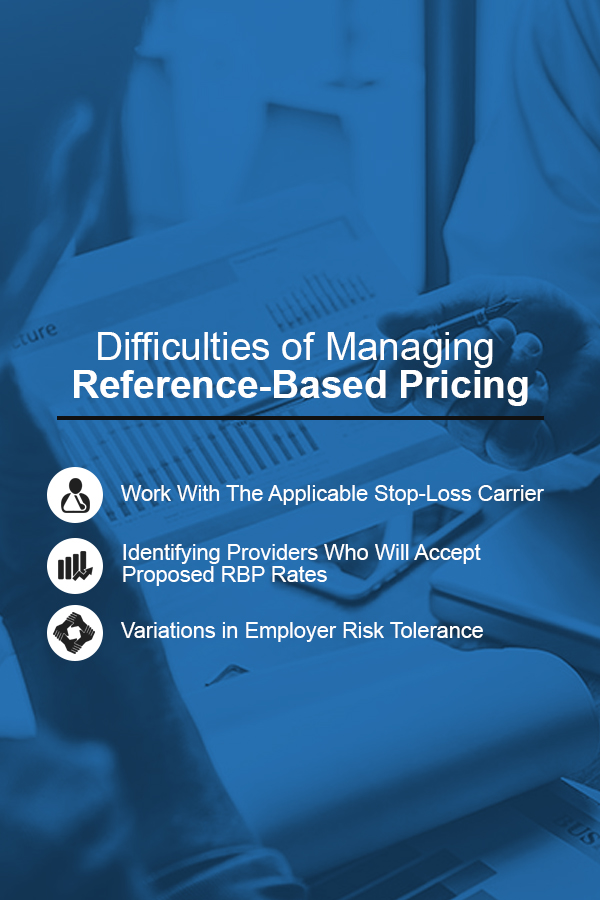
Unlike traditional “insurance,” like an individual would have through a health insurance marketplace, employer-sponsored self-funded health plans do not have a virtually unlimited pool of money from which they can pay medical claims. Employers choose self-funding since they can offer employees affordable, robust coverage – but the lack of regulation inherent in medical provider billing has caused some health plan sponsors to think twice about their insurance offerings. Rather than abandon self-funding entirely, though, many plan sponsors have begun to utilize reference-based pricing instead.
At its core, reference-based pricing is a way that health plans can root their claims spending in objective, industry-accepted metrics, rather than a baseline of arbitrary, unchecked, and often exorbitant provider billing.
While many view reference-based pricing as an immediate solution – and it certainly has proven to be a useful cost-containment tool for many – others view it as a way to change the industry for the better. In other words, many proponents of reference-based pricing do not view it as a permanent solution, but as a catalyst for systemic change.
What Is Reference-Based Pricing?

Also known as Medicare Reference-Based Pricing, Reference Pricing, or other terms, reference-based pricing describes any claim pricing methodology grounded in analysis of an objective value for medical services, and adjudicating medical claims based on some multiple of that value. Popular parameters used for reference-based pricing include Medicare pricing, the provider’s reported costs, average wholesale price, third party databases, and more. Simply put, reference-based pricing is so named because the plan’s pricing is based on a reference.
Reference-based pricing is a payment methodology that replaces or enhances a health plan’s traditional “usual and customary” pricing for non-contracted claims. Rather than calculating the average charge of providers in a geographic area or a similar traditional methodology, a health plan utilizing reference-based pricing instead adjudicates its allowable amount for medical claims based on its chosen metric (most commonly Medicare rates, or a certain percentage above those rates), which is a price that the payor deems reasonable. This presents a much more objective framework for determining reasonable and market-based payments – since billed charges (and therefore the traditional PPO model of percentage discounts off of those billed charges) are so often nonsensical.
Some health plans utilizing reference-based pricing choose to eradicate their network access entirely – terminating all network contracts, treating all claims as out-of-network, and applying reference-based pricing to all claims. Other health plans take a more cautious approach by retaining a traditional PPO network and applying reference-based pricing to only non-contracted claims. Others choose a middle ground between these two approaches, using some combination of direct provider contracts, narrow networks, physician-only networks, or specialty networks, and only applying reference-based pricing to any claims falling outside of the chosen contracting structure.
Carve-outs are also a form of reference-based pricing; perhaps the most common carve-out is for dialysis, whereby the plan pays dialysis claims based on Medicare rates, but pays all other services pursuant to a PPO. Carve-outs are generally not what is thought of when reference-based pricing is conceptualized – but any time a benefit is paid at a percentage of Medicare (or any other “reference”), it is a form of reference-based pricing.
The ultimate goal of reference-based pricing is cost-containment, but not just in terms of actual claim spend for the health plan. The effects of reference-based pricing trickle down to members (who pay lower plan contributions, since the plan’s costs are lower), stop-loss carriers (who see fewer claims that hit the specific or aggregate deductible, since the plan’s payment levels are lower), and even the plan’s procedural costs (for instance, no network access fees, and lower stop-loss premiums due to lower claim spend).
How Does Reference-Based Pricing Work?
Reference-based pricing methodologies vary greatly based on preferences of employers, TPAs, brokers, reference-based pricing vendors, and even stop-loss carriers, in some cases. There are some basic and near-universal principles, which include the following:
- Document harmonization. Like every other right a health plan has, it is not effective unless it is written in the Plan Document. The Plan Document must therefore be amended or restated to include reference-based pricing language; most important are the basic payment terms, including the percentage of Medicare upon which the plan will pay.
- Claims repricing. For an RBP program to be successful, the health plan must be able to accurately price claims based on the metric as defined within the Plan Document. When challenged, it is extremely important that the plan be able to defend itself by being able to back up its pricing using reliable data.
- Patient advocacy. When patients have nowhere to turn for help with balance-billing, that is when so many reference-based pricing programs fail. Providing resources for the patient is the only way to ensure the best outcomes within a reference-based pricing program.
- Escalation. In the somewhat rare instance when good faith discussions with the provider fail, the plan is going to need more options. Those options come in various forms and differ by vendor, but certain plan sponsors also have different levels of risk tolerance that determine which options they choose to pursue.
Difficulties of Managing Reference-Based Pricing

RBPs are not without their obstacles. Organizations interested in implementing an RBP policy must address the following:
1. Work With the Applicable Stop-Loss Carrier
It is essential for employers adopting RBP to consult with their stop-loss carriers first. Even when plans utilize reference-based pricing, some claims may still reach specific and aggregate deductibles, and it is essential to know how the carrier will treat those claims when the time comes. While some carriers cap their own allowable payment amount at the amount the Plan Document provides (such as 150% of Medicare), other carriers are more appreciative of the plan’s attempt to lower overall claims spend, and are willing to work with the plan in cases where negotiation is necessary to resolve balance-billing issues. Even if the provider is unwilling to work with the plan, it is still crucial to have that information going into any given large claim situation.
2. Identifying Providers Who Will Accept Proposed RBP Rates
Because balance-billing is realistically the only barrier to utilizing reference-based pricing, many employers and TPAs find value in entering into contracts with certain physicians, hospitals, or hospital systems. Although it is sometimes the case that these contracts are at rates higher than the plan’s reference-based pricing rate, plans and providers are often able to enter into amicable payment arrangements to protect patients from balance-billing. For many health plans, the knowledge that a patient can visit a certain provider and not have to worry about balance-billing is more than worth a small amount above what the health plan would normally pay.
3. Variations in Employer Risk Tolerance
Many employers are presented with the idea of reference-based pricing and sold on the idea of lowering costs. While balance-billing is a real threat, many vendors who sell reference-based pricing support services tend to minimize the impact of balance-billing as part of the sales process. Employers who choose to utilize reference-based pricing should ensure that they are made acutely aware of its processes and risks.
Is Reference-Based Pricing a Good Option?

The answer to this question depends on many factors.
- What is our employee base? The employee population of a given self-funded group is an important factor. For instance, a young and healthy technology start-up may not benefit as much from reference-based pricing, since it will statistically have fewer large claims that require significant cost-savings. On the other hand, a union group with older or fewer healthy individuals may benefit more on a day-to-day basis, but it’s also important to consider the relative impact that balance-billing can have from a human resources perspective on both of these example groups. Of course, most groups will have their own circumstances to consider.
- Are we located in a geographic area with enough providers who accept reference-based pricing to build an equitable in-network ecosystem? Small or rural communities that can be characterized as “one-hospital towns” are less ripe for reference-based pricing; this methodology tends to thrive where there is competition between hospitals, since a one-hospital town has little or no incentive to work with health plans, since there is nowhere to incentivize patients to go instead.
- Do we have employee buy-in to make the switch? Reference-based pricing restructures the very concept of health insurance that has always been so familiar to most employees. It is a good idea to discuss this change with employees prior to making any drastic change like this one. Employees should ideally be given the information so they can weigh lower plan costs and contributions against the possibility of balance-billing.

- Will we use RBP for all or only certain claims? Reference-based pricing is not an all-or-nothing concept. Many options exist, such as utilizing reference-based pricing for all claims, for only facility claims, for only out-of-network claims, and many others. Individual health plans will need to weigh their options and choose what makes the most sense for each of them.
Save With The Phia Group
We offer flexible service options that are driven by client needs. Learn more about our claim negotiation process and start saving money with The Phia Group, today!